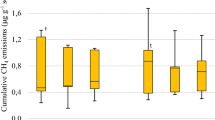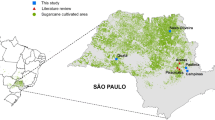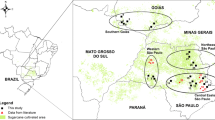Abstract
Sugarcane (Saccharum officinarum L.) straw is a promising feedstock for bioelectricity and cellulosic ethanol in Brazil, but some straw is also needed to sustain nutrient cycling and crop yields. A literature review and two field studies were conducted to quantify above-ground macronutrient accumulation by sugarcane. Five straw removal scenarios using different amounts of biomass and nutrient composition data of top (green) and bottom (dry) leaves were constructed to estimate fertilizer requirements associated with straw removal in central southern Brazil. Calculated straw removal for five scenarios (S1 to S5) was 3.5, 7, 3, 6, and 12 Mg ha−1, respectively. By removing 12 Mg ha−1 of straw (S5), the potential N, P, K, Ca, Mg, and S removal was 69, 7, 92, 45, 16, and 14 kg ha−1, respectively. It represents a nutrient (NPK) replacement cost of US$ 90.00 ha−1 or US$ 7.60 per Mg of removed straw. The scenario analysis shows that less-impacting strategies are those that maintain top leaves in the field and harvesting only bottom leaves (S1 and S2), whereas total removal (S5) could double NPK-fertilizer consumption in sugarcane fields by 2050. Our findings provide stakeholder guidelines for improved straw management, establish an economic value for accumulated plant nutrients, and promote both socio-economic and environmental benefits of more sustainable bioenergy production in Brazil.





Similar content being viewed by others
Change history
07 February 2020
The original version of this article was published with a wrong heading by mistake. The correct heading is Original Paper.
References
Oliveira DMS, Cherubin MR, Franco ALC, Santos AS, Gelain JG, Dias NMS, Diniz TR, Almeida AN, Feigl BJ, Davies CA, Paustian K, Karlen DL, Smith P, Cerri CC, Cerri CEP (2019) Is the expansion of sugarcane over pasturelands a sustainable strategy for Brazil's bioenergy industry? Renew Sust Energ Rev 102:346–355
Macedo IC, Leal MRLV, Silva JEAR (2004) Balanço das emissões de gases do efeito estufa na produção e no uso do etanol no Brasil São Paulo: Secretaria de Meio Ambiente do Estado de São Paulo 37p
Goldemberg J (2007) Ethanol for a sustainable energy future. Science 315:808–810
Food and Agriculture Organization of the United Nations – FAO (2017) FAOSTAT – production – crops: sugarcane. http://wwwfaoorg/faostat/en/ Accessed 20 Dec 2018
Companhia Nacional de Abastecimento – Conab (2019) Acompanhamento de safra brasileira de cana-de-açúcar. v. 6 - Safra 2019/2020, n° 1 – Primeiro Levantamento, Brasília. https://www.conab.gov.br/info-agro/safras/cana Accessed 24 Jun 2019
Ministério de Minas e Energia, Brasil – MME (2018) RENOVABIO program. http://wwwmmegovbr/web/guest/secretarias/petroleo-gas-natural-e-combustiveis-renovaveis/programas/renovabio/principal Accessed 28 Feb 2019
Brazil (2015) intended Nationally Determined Contributions (iNDC) - Brazil. http://www.mma.gov.br/images/arquivos/clima/convencao/indc/BRAZIL_iNDC_english.pdf Accessed 26 Feb 2019
Carvalho JLN, Nogueirol RC, Menandro LMS, Bordonal RO, Borges CD, Cantarella H, Franco HCJ (2017) Agronomic and environmental implications of sugarcane straw removal: a major review. Glob Change Biol Bioenergy 9:1181–1195
Menandro LMS, Cantarella H, Franco HCJ, Kölln OT, Pimenta MTB, Sanches GM, Rabelo SC, Carvalho JLN (2017) Comprehensive assessment of sugarcane straw: implications for biomass and bioenergy production. Biofuels Bioprod Biorefin 11:488–504
Cherubin MR, Oliveira DMS, Feigl BJ, Pimentel LG, Lisboa IP, Gmach MR, Varanda LL, Moraes MC, Satiro LS, Popin GV, Paiva SR, Santos AKB, Vasconcelos ALS, Melo PLA, Cerri CEP, Cerri CC (2018) Crop residue harvest for bioenergy production and its environmental implications: a review. Sci Agric 75:255–272
Lisboa IP, Cherubin MR, Satiro LS, Siquera-Neto M, Lima RP, Gmach MR, Wienhold BJ, Schmer MR, Jin VL, Cerri CC, Cerri CEP (2019) Applying soil management assessment framework (SMAF) on short-term sugarcane straw removal in Brazil. Ind Crop Prod 129:175–184
Carvalho JLN, Hudiburg TW, Franco HCJ, DeLucia EH (2017) Contribution of above- and belowground bioenergy crop residues to soil carbon. Glob Change Biol Bioenergy 9:1333–1343
Sousa JGA Jr, Cherubin MR, Oliveira BG, Cerri CEP, Cerri CC, Feigl BJ (2018) Three-year soil carbon and nitrogen responses to sugarcane straw management. Bioenerg Res 11:249–261
Bordonal RO, Carvalho JLN, Lal R, Figueiredo EB, Oliveira BG, La Scala JN (2018a) Sustainability of sugarcane production in Brazil. A review. Agron Sustain Dev 38:13
Graham MH, Haynes RJ (2006) Organic matter status and the size, activity and metabolic diversity of the soil microbial community in the row and inter-row of sugarcane under burning and trash retention. Soil Biol Biochem 38:21–31
Satiro LS, Cherubin MR, Safanelli JL, Lisboa IP, da Rocha Jr PR, Cerri CEP, Cerri CC (2017) Sugarcane straw removal effects on Ultisols and Oxisols in south-Central Brazil. Geoderma Regional 11:86–95
Castioni GA, Cherubin MR, Menandro LMS, Sanches GM, Bordonal RO, Barbosa LC, Carvalho JLN (2018) Soil physical quality response to sugarcane straw removal in Brazil: a multi-approach assessment. Soil Tillage Res 184:301–309
Fortes C, Trivelin PCO, Vitti AC (2012) Long-term decomposition of sugarcane harvest residues in Sao Paulo state, Brazil. Biomass Bioenergy 42:189–198
Trivelin PCO, Franco HCJ, Otto R, Ferreira DA, Vitti AC, Fortes C, Faroni CE, Oliveira ECA, Cantarella H (2013) Impact of sugarcane trash on fertilizer requirements for São Paulo, Brazil. Sci Agric 70:345–352
Oliveira MW, Trivelin PCO, Penatti CP, Piccollo MC (1999) Decomposição e liberação de nutrientes da palhada de cana-de-açúcar em campo. Pesq Agrop Brasileira 34:2359–2362
Robertson FA, Thorburn PJ (2007) Management of sugarcane harvest residues: consequences for soil carbon and nitrogen. Aust J Soil Res 45:13–23
Meier EA, Thorburn PJ (2016) Long term sugarcane crop residue retention offers limited potential to reduce nitrogen fertilizer rates in Australian wet tropical environments. Front Plant Sci 7:1017
Associação Nacional para Difusão de Adubos - ANDA (2017) Anuário estatístico do setor de fertilizantes: 2017. São Paulo. http://anda.org.br/index.php?mpg=03.00.00 Accessed 22 Jan 2019
Pitombo M, Cantarella H, Packer APC, Ramos NP, Carmo JB (2017) Straw preservation reduced total N2O emissions from a sugarcane field. Soil Use Manag 33:583–594
Vasconcelos ALS, Cherubin MR, Feigl BJ, Cerri CE, Gmach MR, Siqueira-Neto M (2018) Greenhouse gas emission responses to sugarcane straw removal. Biomass Bioenergy 113:15–21
Karlen DL, Kovar JL, Birrell SJ (2015) Corn Stover nutrient removal estimates for Central Iowa, USA. Sustainability 2015:8621–8634
Yin H, Zhao W, Li T, Cheng X, Liu Q (2018) Balancing straw returning and chemical fertilizers in China: role of straw nutrient resources. Renew Sust Energ Rev 81:2695–2702
Franco HCJ, Pimenta MTB, Carvalho JLN, Magalhães PSG, Rossell CEV, Braunbeck OA, Vitti AC, Kölln OT, Rossi Neto J (2013) Assessment of sugarcane trash for agronomic and energy purposes in Brazil. Sci Agric 70:305–312
Soil Survey Staff (2014) Keys to Soil Taxonomy, 12th edn. USDA - Natural Resources Conservation Service, Washington, DC 360 pp
Lisboa IP, Cherubin MR, Lima RP, Cerri CC, Satiro LS, Wienhold BJ, Schmer MR, Jin VL, Cerri CEP (2018) Sugarcane straw removal effects on plant growth and stalk yield. Ind Crop Prod 111:794–806
Malavolta E, Vitti GC, De Oliveira SA (1997) Avaliação do estado nutricional das plantas: princípios e aplicações. Potafos, Piracicaba
Spitzer M, Wildenhain J, Rappsilber J, Tyers M (2014) BoxPlotR: a web tool for generation of box plots. Nat Methods 11:121–122. https://doi.org/10.1038/nmeth.2811
Leal MRLV, Walter AS, Seabra JEA (2013) Sugarcane as na energy source. Biomass Conv Bioref 3:17–26
Lisboa IP, Cherubin MR, Cerri CC, Cerri DG, Cerri CEP (2017) Guidelines for the recovery of sugarcane straw from the field during harvesting. Biomass Bioenergy 96:69–74
Cardoso TF, Watanabe MDB, Sousa A, Chagas MF, Cavalett O, Morais ER, Nogueira LAH, Leal MELV, Braunbeck OA, Cortez LAB, Bonomi A (2017) Economic, environmental, and social impacts of different sugarcane production systems. Biofuels Bioprod Biorefin 12:68–82
The World Bank (2018) Preço das mercadorias. http://wwwindexmundicom/pt/pre%E7os-de-mercado Accessed 13 Feb 2019
Karlen DL, Birrell SJ, Johnson JMF, Osborne SL, Schumacher TE, Varvel GE, Ferguson RB, Novak JM, Fredrick JR, Baker JM, Lamb JA, Adler PR, Roth GW, Nafziger ED (2014) Multilocation corn Stover harvest effects on crop yields and nutrient removal. Bionerg Res 7:528–539
Sousa JGA Jr, Cherubin MR, Cerri CEP, Cerri CC, Feigl BJ (2017) Sugar cane straw left in the field during harvest: decomposition dynamics and composition changes. Soil Res 55:758–768
Pimentel LG, Cherubin MR, Oliveira DMS, Cerri CEP, Cerri CC (2019) Decomposition of sugarcane straw in the central-southern Brazil: basis for management decisions for bioenergy production. Biomass Bionergy 122:133–144
Varanda LL, Cherubin MR, Cerri CEP (2019) Decomposition dynamics altered by straw removal management in the sugarcane expansion regions in Brazil. Soil Res 57:41–52
Carmo JB, Filoso S, Zotelli LC, Sousa Neto ER, Pitombo LM, Duarte-Neto PJ, Vargas VP, Andrade CA, Gava GJC, Rossetto R, Cantarella H, Neto AE, Martinelli LA (2013) Infield greenhouse gas emissions from sugarcane soils in Brazil: effects from synthetic and organic fertilizer application and crop trash accumulation. Glob Change Biol Bioenergy 5:267–280
Robertson FA, Thorburn PJ (2007) Decomposition of sugarcane harvest residue in different climatic zones. Aust J Soil Res 45:1–11
Dourado Neto D, Powlson D, Abu Bakar R, Bacchi OOS, Basanta MV, Thi Cong P, Keerthisinghe S, Ismaili M, Rahman SM, Reichardt K, Safwat MSA, Sangakkara R, Timm LC, Wang JY, Zagal E, Van Kessel C (2010) Multiseason recoveries of organic and inorganic nitrogen-15 in tropical cropping systems. Soil Sci Soc Am J 74:139–152
Ferreira DA, Franco HCJ, Otto R, Vitti AC, Fortes C, Faroni CE, Garside AL, Trivelin PCO (2016) Contribution of N from green harvest residues for sugarcane nutrition in Brazil. Glob Change Biol Bioenergy 8:859–866
Vieira-Megda MX, Mariano E, Leite JM, Franco HCJ, Vitti AC, Megda MM, Khan SA, Mulvaney RL, Trivelin PCO (2015) Contribution of fertilizer nitrogen to the total nitrogen extracted by sugarcane under Brazilian field conditions. Nutr Cycl Agroecosyst 101:241–257
Gonzaga LC, Carvalho JLN, Oliveira BG, Soares JR, Cantarella H (2018) Crop residue removal and nitrification inhibitor application as strategies to mitigate N2O emissions in sugarcane fields. Biomass Bioenergy 119:206–216
Otto R, Castro SA, Mariano E, Castro SG, Franco HC, Trivelin PC (2016) Nitrogen use efficiency for sugarcane-biofuel production: what is next? Bioenerg Res 9:1272–1289
Pinheiro PL, Recous S, Dietrich G, Weiler DA, Giovelli RL, Mezzalira AP, Giacomini SJ (2018) Straw removal reduces the mulch physical barrier and ammonia volatilization after urea application in sugarcane. Atmos Environ 194:179–187
Marschner H (2012) Marschner’s mineral nutrition of higher plants, 3rd edn. Academic Press, London
Withers PJA, Rodrigues M, Soltangheisi A, Carvalho TS, Guilherme LRG, Benites VM, Gatiboni LC, de Sousa DMG, Nunes RS, Rosolem CA, Andreote FD, Oliveira A Jr, Coutinho ELM, Pavinato PS (2018) Transitions to sustainable management of phosphorus in Brazilian agriculture. Sci Rep 8:2537
Damon PM, Bowden B, Rose T, Rengel Z (2014) Crop residue contributions to phosphorus pools in agricultural soils: a review. Soil Biol Biochem 74:127–137
Noack SR, McLaughlin MJ, Smernik RJ, McBeath TM, Armstrong RD (2012) Crop residue phosphorus: speciation and potential bio-availability. Plant Soil 359(1–2):375–385
Ha KV, Marschner P, Bünemann EK (2008) Dynamics of C, N, P and microbial community composition in particulate soil organic matter during residue decomposition. Plant Soil 303(1–2):253–264
Zhu J, Li M, Whelan M (2018) Phosphorus activators contribute to legacy phosphorus availability in agricultural soils: a review. Sci Total Environ 612:522–537
Singh Y, Singh B, Timsina T (2005) Crop residue management for nutrient cycling and improving soil porosity in rice-based cropping systems in the tropics. Adv Agron 85:269–407
Pavinato PS, Rosolem CR (2008) Disponibilidade de nutrientes no solo - decomposição e liberação de compostos orgânicos de resíduos vegetais. R Bras Ci Solo 32:911–920
Cavagnaro TR, Bender SF, Asghari HR, Van Der Heijden MGA (2015) The role of arbuscular mycorrhizas in reducing soil nutrient loss. Trends Plant Sci 20:283–290
Valim WC, Panachuki E, Pavei DS, Alves Sobrinho T, Almeida WS (2016) Effect of sugarcane waste in the control of interrill erosion. Semin: Cien Agrar 37:1155–1164
Andrade NS, Martins Filho MV, Torres JL, Pereira GT, Marques Júnior J (2011) Impacto técnico e econômico das perdas de solo e nutrientes por erosão no cultivo da cana-de-açúcar. Engenharia Agrícola 31:539–550
Souza JP Jr, Flores RA, Prado RM, Moda LR (2015) Release of potassium, calcium and magnesium from sugarcane straw residue under different irrigation regimes. Aust J Crop Sci 9:767–771
Hawkesford M, Horst W, Kichey T, Lambers H, Schjoerring J, Müller IS, White P (2012) Functions of macronutrients: potassium. In: Marschner P (ed) Marschner’s mineral nutrition of higher plants. Elsevier, Adelaide, pp 135–189
Almeida HJ, Cruz FJR, Pancelli MA, Flores RA, Vasconcelos RL, Prado RM (2015) Decreased potassium fertilization in sugarcane ratoons grown under straw in different soils. Aust J Crop Sci 9:596–604
Leite JM, Ciampitti IA, Mariano E, Vieira-Megda MX, Trivelin PCO (2016) Nutrient partitioning and stoichiometry in unburnt sugarcane ratoon at varying yield levels. Front Plant Sci 7:466
Mariano E, Otto R, Montezano ZF, Cantarella H, Trivelin PCO (2017) Soil nitrogen availability indices as predictors of sugarcane nitrogen requirements. Eur J Agron 89:25–37
Raij BV, Cantarella H, Quaggio JA, Furlani AMC (1997) Recomendações de adubação e calagem para o estado de São Paulo. Campinas: Instituto Agronômico/ Fundação IAC. Boletim técnico 100 285 p
Ghiberto PJ, Libardi PL, Trivelin PCO (2015) Nutrient leaching in an Ultisol cultivated with sugarcane. Agric Water Manag 148:141–149
Mosier AR, Duxbury JM, Freney JR, Heinemeyer O, Minami K (1998) Assessing and mitigating N2O emissions from agricultural soils. Climate Change 40:7–38
Companhia Nacional de Abastecimento – Conab (2018) Custos de Produção – Cultura Semi-Perene – Cana-de-açúcar - SP. https://wwwconabgovbr/info-agro/custos-de-producao/planilhas-de-custo-de-producao/itemlist/category/407-planilhas-de-custos-de-producao-culturas-semi-perenes Accessed 28 Feb 2019
Bordonal RO, Menandro LMS, Barbosa LC, Lal R, Milori DMBP, Kolln OT, Franco HCJ, Carvalho JLN (2018) Sugarcane yield and soil carbon response to straw removal in south-Central Brazil. Geoderma 328:79–90
Matsuura MISF, Scachetti MT, Chagas MF, Seabra JEA, Moreira MMR, Bonomi, AM, Bayma G, Picoli JF, Morandi MAB, Ramos NP, Cavalett O, Novaes RML (2018). RenovaCalcMD: Método e ferramenta para a contabilidade da Intensidade de Carbono de Biocombustíveis no Programa RenovaBio. 58 p http://wwwanpgovbr/images/Consultas_publicas/2018/n10/CP10-2018_Nota-Tecnica-Renova-Calcpdf Accessed 28 Feb 2019
Alexander AG (1985) The energy cane alternative. Elsevier Science Publishers B.V, Amsterdam
Araújo R, Alves Junior J, Casaroli D, Evangelista AWP (2016) Variation in the sugar yield in response to drying-off of sugarcane before harvest and the occurrence of low air temperatures. Bragantia 75:118–127
Funding
The Brazilian Development Bank (BNDES) and Raízen Energia S.A funded this project (Project #14.2.0773.1). MRC, LLV, and PSP received the research grant (#2018/09845-7) and scholarships (#2016/08214-8; 2017/04186-2) from the São Paulo Research Foundation–FAPESP. AGBS received his post-doctoral fellowship from the Fundação de Estudos Agrários “Luiz de Queiroz” (Project #67555). RO received a research productivity fellowship from the National Council for Scientific and Technological Development (CNPq), grant #308007/2016-6. This study was financed in part by the Coordenação de Aperfeiçoamento de Pessoal de Nível Superior-Brasil (CAPES)-Finance Code 001”. IPL received his PhD scholarships and post-doc fellowship from the CAPES (#88881.134605/2016-01) and CNPq (#141459/2015-8, #201207/2017-6; and #155753/2018-5).
Author information
Authors and Affiliations
Corresponding author
Additional information
Publisher’s Note
Springer Nature remains neutral with regard to jurisdictional claims in published maps and institutional affiliations.
Electronic supplementary material
ESM 1
(DOCX 166 kb)
Rights and permissions
About this article
Cite this article
Cherubin, M.R., Lisboa, I.P., Silva, A.G.B. et al. Sugarcane Straw Removal: Implications to Soil Fertility and Fertilizer Demand in Brazil. Bioenerg. Res. 12, 888–900 (2019). https://doi.org/10.1007/s12155-019-10021-w
Published:
Issue Date:
DOI: https://doi.org/10.1007/s12155-019-10021-w




